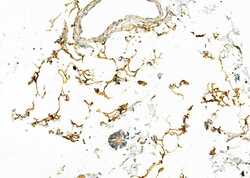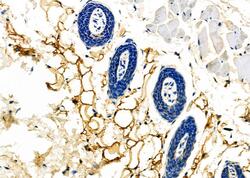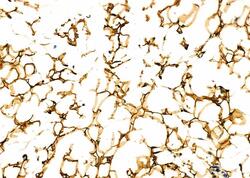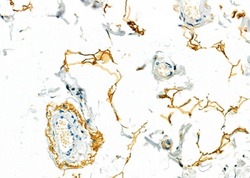Antibody data
- Antibody Data
- Antigen structure
- References [0]
- Comments [0]
- Validations
- Immunocytochemistry [3]
- Immunohistochemistry [4]
Submit
Validation data
Reference
Comment
Report error
- Product number
- PA5-118878 - Provider product page

- Provider
- Invitrogen Antibodies
- Product name
- Perilipin 1 Polyclonal Antibody
- Antibody type
- Polyclonal
- Antigen
- Synthetic peptide
- Description
- Antibody detects endogenous levels of total Perilipin-1.
- Reactivity
- Human, Mouse, Rat
- Host
- Rabbit
- Isotype
- IgG
- Vial size
- 100 μL
- Concentration
- 1 mg/mL
- Storage
- -20°C
No comments: Submit comment
Supportive validation
- Submitted by
- Invitrogen Antibodies (provider)
- Main image

- Experimental details
- Immunocytochemical analysis of Perilipin 1 in A431 cells using a Perilipin 1 polyclonal antibody (Product # PA5-118878). The samples were with PFA and permeabilized in 0.1% saponin prior to blocking in 10% serum for 45 minutes at 37°C. The primary antibody was diluted 1:200 and incubated with the sample for 1 hour at 37°C. A Alexa Fluor 594 conjugated goat polyclonal to rabbit IgG (H+L), diluted 1:600 was used as secondary antibody.
- Submitted by
- Invitrogen Antibodies (provider)
- Main image

- Experimental details
- Immunocytochemical analysis of Perilipin 1 in A431 cells using a Perilipin 1 polyclonal antibody (Product # PA5-118878). The samples were with PFA and permeabilized in 0.1% saponin prior to blocking in 10% serum for 45 minutes at 37°C. The primary antibody was diluted 1:200 and incubated with the sample for 1 hour at 37°C. A Alexa Fluor 594 conjugated goat polyclonal to rabbit IgG (H+L), diluted 1:600 was used as secondary antibody.
- Submitted by
- Invitrogen Antibodies (provider)
- Main image

- Experimental details
- Immunocytochemical analysis of Perilipin 1 in A431 cells using a Perilipin 1 polyclonal antibody (Product # PA5-118878). The samples were with PFA and permeabilized in 0.1% saponin prior to blocking in 10% serum for 45 minutes at 37°C. The primary antibody was diluted 1:200 and incubated with the sample for 1 hour at 37°C. A Alexa Fluor 594 conjugated goat polyclonal to rabbit IgG (H+L), diluted 1:600 was used as secondary antibody.
Supportive validation
- Submitted by
- Invitrogen Antibodies (provider)
- Main image

- Experimental details
- Immunohistochemical analysis of Perilipin 1 in Human colorectal cancer using a Perilipin 1 polyclonal antibody (Product # PA5-118878). The sample was formaldehyde fixed and a heat mediated antigen retrieval step in citrate buffer was performed. The sample was then blocked and incubated with the primary antibody at 4°C overnight. An HRP conjugated anti-Rabbit antibody was used as the secondary antibody.
- Submitted by
- Invitrogen Antibodies (provider)
- Main image

- Experimental details
- Immunohistochemical analysis of Perilipin 1 in Mouse skin tissue using a Perilipin 1 polyclonal antibody (Product # PA5-118878). The sample was formaldehyde fixed and a heat mediated antigen retrieval step in citrate buffer was performed. The sample was then blocked and incubated with the primary antibody at 4°C overnight. An HRP conjugated anti-Rabbit antibody was used as the secondary antibody.
- Submitted by
- Invitrogen Antibodies (provider)
- Main image

- Experimental details
- Immunohistochemical analysis of Perilipin 1 in Mouse ovarian tissue using a Perilipin 1 polyclonal antibody (Product # PA5-118878). The sample was formaldehyde fixed and a heat mediated antigen retrieval step in citrate buffer was performed. The sample was then blocked and incubated with the primary antibody at 4°C overnight. An HRP conjugated anti-Rabbit antibody was used as the secondary antibody.
- Submitted by
- Invitrogen Antibodies (provider)
- Main image

- Experimental details
- Immunohistochemical analysis of Perilipin 1 in Human colorectal cancer and adjacent normal tissues using a Perilipin 1 polyclonal antibody (Product # PA5-118878). The sample was formaldehyde fixed and a heat mediated antigen retrieval step in citrate buffer was performed. The sample was then blocked and incubated with the primary antibody at 4°C overnight. An HRP conjugated anti-Rabbit antibody was used as the secondary antibody.
 Explore
Explore Validate
Validate Learn
Learn Western blot
Western blot Immunocytochemistry
Immunocytochemistry